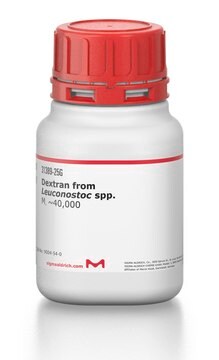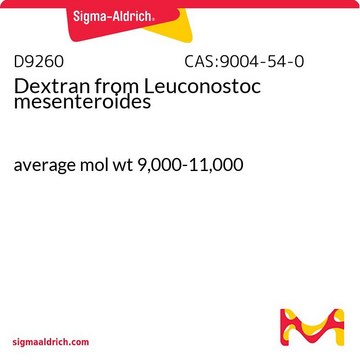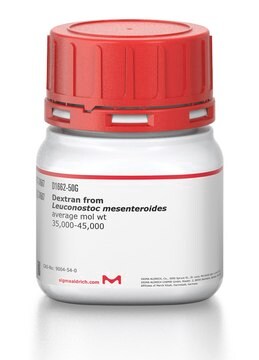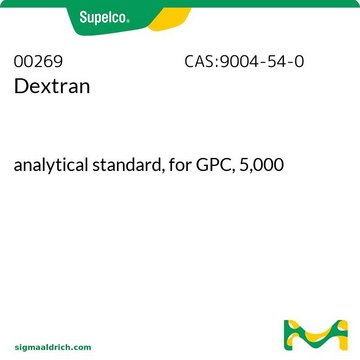About This Item
Recommended Products
biological source
(Leuconostoc spp)
form
powder
mol wt
Mr ~6,000
color
white
mp
483 °C ((901 °F ))
solubility
water: 1.5 g/10 mL, colorless to faintly yellow
storage temp.
room temp
InChI
1S/C18H32O16/c19-1-5(21)9(23)10(24)6(22)3-31-17-16(30)14(28)12(26)8(34-17)4-32-18-15(29)13(27)11(25)7(2-20)33-18/h1,5-18,20-30H,2-4H2
InChI key
FZWBNHMXJMCXLU-UHFFFAOYSA-N
Looking for similar products? Visit Product Comparison Guide
General description
Application
- for the glycation of caseinate to investigate the influence of an increase in carbohydrate chain length compared to glucose
- for the mass calibration of matrix-assisted laser desorption ionization-time of flight mass spectroscopy (MALDI-TOF) for the characterization of silver nanoparticles (AgNPs)
- as a non-toxic stabilizer to assess the in vivo administration of tungsten trioxide(WO3) nanoparticles
Biochem/physiol Actions
Other Notes
Storage Class Code
11 - Combustible Solids
WGK
WGK 2
Personal Protective Equipment
Certificates of Analysis (COA)
Search for Certificates of Analysis (COA) by entering the products Lot/Batch Number. Lot and Batch Numbers can be found on a product’s label following the words ‘Lot’ or ‘Batch’.
Already Own This Product?
Find documentation for the products that you have recently purchased in the Document Library.
Customers Also Viewed
Articles
Dmitri Simberg (University of Colorado Anschutz Medical Campus, USA) reviews the used of dextran and cyclodextrin for the synthesis of nanoparticles used in drug delivery applications.
Dmitri Simberg (University of Colorado Anschutz Medical Campus, USA) reviews the used of dextran and cyclodextrin for the synthesis of nanoparticles used in drug delivery applications.
Our team of scientists has experience in all areas of research including Life Science, Material Science, Chemical Synthesis, Chromatography, Analytical and many others.
Contact Technical Service












